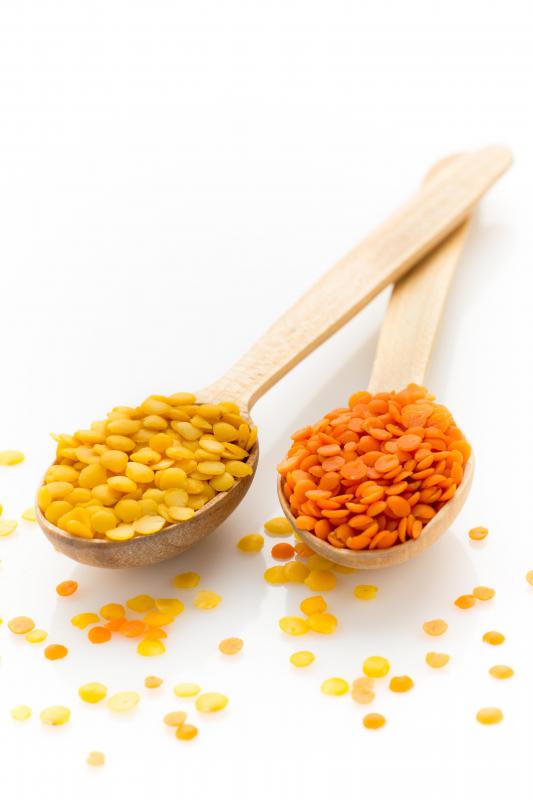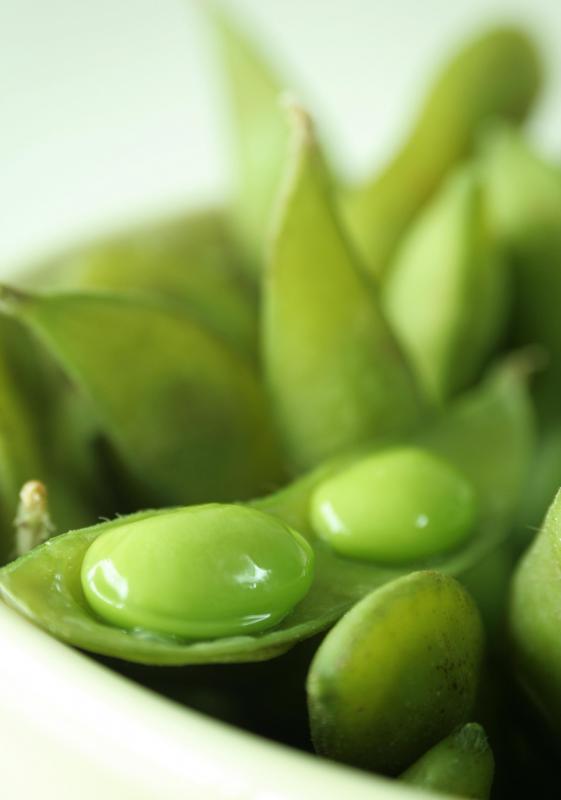At DelightedCooking, we're committed to delivering accurate, trustworthy information. Our expert-authored content is rigorously fact-checked and sourced from credible authorities. Discover how we uphold the highest standards in providing you with reliable knowledge.
Which Beans Have the Most Protein?
As many people are aware, beans and legumes are a very protein rich source of food. In addition to being high in protein, they also have a high concentration of vitamins and minerals. These nutritional qualities make them a popular choice for vegetarians, although other people can benefit from eating beans as well. Although only soybeans contain complete proteins by themselves, all varieties have a fair amount of protein in every serving although some are higher in protein than others. Beans should be cooked thoroughly to avoid intestinal discomfort and its sometimes socially undesirable symptoms.
The superpower of the bean world is soybeans, which contain 29 grams for every 1 cup (172 g) cooked serving. Edamame, green soybeans which are picked before full maturity, have 22 grams of protein in every cooked 1 cup (180 g) serving. They can be added to salads or eaten like a snack food, or made into foods like tofu and tempeh. There are lots of ways to use soy in cooking, but chefs should try not to go overboard, as it is possible to eat too much of a good thing.

Fava beans are another protein-rich bean, with 13 grams of protein per 1 cup (170 g) serving. Lentils are also high in protein, with most lentils having around 17 grams per cup (198 g). Following close behind are red kidney beans, with about 16 grams in a 1 cup (177 g) serving. Black beans and navy or haricot beans have 15 grams of protein per cup (172 g and 182 g), while black-eyed peas, garbanzos, and limas have around 14 grams per cup (170 g, 164 g, and 170 g each).

Most beans by themselves do not provide complete proteins. A complete protein is one that contains all essential nine amino acids in the right proportions. It's common to combine them with other foods to make a complete protein, such as in the popular combination of beans and rice.
People's protein needs vary depending on weight. There are two ways to think about protein needs; in one instance, protein should make up around 20% of total caloric intake. One gram of protein contains four calories, so to determine protein needs this way, a person must figure out what 20% of his or her caloric intake should be and divide by four for the number of grams of protein needed. Generally, healthy adults need 1,800 to 2,000 calories each day, although individual needs may vary depending on health and activity levels. People should ask a medical professional about their diet if they have questions.

Interested people with an eye for precision can figure out his necessary protein by using his weight. Each person needs around 0.8 grams of protein for every kilogram (2.2 pounds) of weight. A person can multiply his weight in kilograms by 0.8 to see how many grams of protein he needs; some people may need as much as 1.8 grams of protein per kilogram of body weight, especially if they are physically active, so it's a good idea to check with a medical professional about precise requirements. Weight in pounds can be divided by 2.2 to get weight in kilograms.
AS FEATURED ON:
AS FEATURED ON:





















Discussion Comments
Soybeans are the most genetically modified bean. Be very wary of them.
Dry roasted soya beans do have a high amount of protein. It has about 40 percent of protein.
I'm saddened to see soy being promoted here. It's well known that GMO's and never was meant for human consumption. They should use it strictly for candles and fibers.
Does anyone know how much rice--or other grain--must be eaten with a serving of beans to get "complete" protein? Should it be half and half or can it be more of one or the other?
I wouldn't necessarily say that this is the "right formula" - that's pretty subjective. I aim for 300 grams of protein every day, and at 260 pounds, that's well over 1.8 grams per kilo (more like 2.5). It's all a matter of what you're after. The bottom line is: do your own homework if you want to reach your goals, not a "personal trainer."
Finally an article with the correct formula to find out your protein needs: .8 for the average person; 1.4 for the working out person and 1.8 ( max) for those trying to put on serious muscle. Good article. - personal trainer
Your body can synthesize any protein as long as it has the amino acids. There could be a factor of your genetic activity. This is my understanding.
So many myths out there. No such thing as an 'incomplete' or 'complete' protein. Get the USDA food database and examine any food with protein in it, every one has ALL 20 amino acids. The particular amino acid profile varies by food, and depending on what you want to accomplish, vary your particular consumption as different tissues will utilize the available aminos by various stimulation and training.
Why not mention that lysine, the missing amino acid, is also found in corn tortillas and hominy as eaten for centuries by early Central Americans?
i heard that too much of beans is not good and in singapore, they underplay soyabeans for fear of cancer. please clarify. i give it to my children of eight years and four years.
The fact that beans do not have complete protein explains why so many recipes from other countries include both rice and beans. It isn't about science, it's about 'grazing' until some combination is found that the body recognizes as 'most suitable'.
Many countries in the mid-east use garbanzo beans (chick peas) as a primary source of protein. In fact, the popular falafel is made by frying a garbanzo bean mixture in small balls - these fried falafel balls are usually served with yet more garbanzo beans in the form of hummus. Hummus is a paste made out of, you guessed it, more garbanzo beans.
It is an interesting case of a type of food being flavored by more of itself!
I've read in a nutritional book that beans lack the full amino acid spectrum and therefore, to gain the full protein benefit, it is better to eat them with rice or corn based foods that will make up the other amino acid. Is this true, and how does your body combine them to make it so?
Just came from large chain grocery store & dry beans there listed lentils as having 10g of protein per 1/4 cup. That would be 40g per cup.
Also dry pinto, navy, & great northern beans were listed as 8g of protein per 1/4 cup so that would be 32g per cup.
All beans are high in fiber, protein and antioxidants and at the same time low in fat. A great health food that also keeps the weight down.
Post your comments